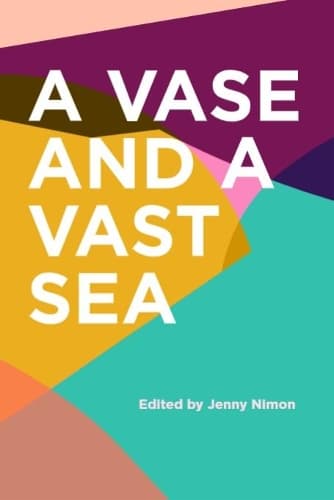A Vase And A Vast Sea
Reviewed by David Hill
Most anthologies aim to introduce and affirm. They bring forward new names, while they also record the progress of established contributors. This one is different.
It's selected from 15 years of 4th Floor journals, published by Whitireia Polytechnic's acclaimed Creative Writing Course. It appears 12 months after the Polytech's administrators chose to take axe, slasher and flame-thrower to the course, for the usual barren economic reasons. So, there's an inevitably elegiac quality to Jenny Nimon's excellent selection. “We miss you already, 4th Floor,” laments publisher Mary-Jane Duffy in her Acknowledgements.
It's a handsome small production: neat, modest and accessible inside Emily Fletcher's brightly abstract cover. Author notes are informative and mostly restrained. (Yes, I do bang on about that second quality; I've read some head-clutchingly precious bios in other collections.)
It holds 40 pieces from almost as many contributors. Only five are male, which is...well, statistically typical. There's a good mixture of prose and poetry, with emphasis on the latter. Quality and craft are evident from the very first lines (Rata Gordon's “If a man was an island / I'd walk his spine and pick his heart”) to Tracy Sullivan's defiant closing chorus (“Again, again, again”).
The final issue of 4th Floor focused on Writing as Activism. Pip Adam sees this anthology as concerned – appropriately, for a valedictory publication – with motifs of time and place. Jenny Nimon notes its inclusion of “the macro and the micro” (nice).
In spite of its inescapably In Memoriam status, there's a satisfyingly celebratory tone to many pieces. Romesh Dissanayake joyously outlines his fantasy nuptials; Ralph Proops assembles artists and authors in the kitchen. The wonderful Renee, still publishing at 91 (sorry, ma'am, I shouldn't mention that figure, but fervent congratulations) affectionately acknowledges a grandmother and grandfather – “a man, it turns out, you are happy to be seen dead with”.
Domestic and personal moments are used also to evoke pauses or hinges in time. So, John Haxton comprehends architecture and colours; Maggie Rainey-Smith scrolls gravely and gladly through a distant summer; Trish Harris transforms a blackberry patch into a transient idyll; Alison Glenny's prose fragments loop across minutes and years.
Places and times are subsumed in different ways into Rob Hack's nifty Pasifika evocation, where “School kids at keyboards see a future elsewhere”. Barbara Else meanwhile remembers shifts of power as a Piranesi print is hung on a wall.
Homes and or gardens make effective focus and metaphor in work by Adrienne Jansen and Charmaine Thomson, and for Cushla Managh's Evans Bay grandma with her state house and letterbox shaped like a ship. (Ex-journalist Managh has another contribution narrating initiation and abuse, that manages to be both wistful and jolting.) Pigeons and a silent old man, or beach and remembered music are starting points for Donna Banicevich Gera and Rachel Kleinsman. Issues are confronted: Anahera Gildea's protagonist enters a world changed by the Land Marches. There are experiments in form and structure, as Tina Regtien applies maths to love.
You feel editor Nimon's respect for her writers all through this selection. Judicious placements mean pieces feed off one another; contrast or complement.
Reviewing any anthology means omitting names. So, bows of apology and nods of recognition go to those not mentioned here. Look for them in A Vase and A Vast Sea's pages; they all repay reading. To 4th Floor, along with Whitireia's Creative Writing Course, Hail and Farewell. If only that second salutation didn't apply.
Reviewed by David Hill
